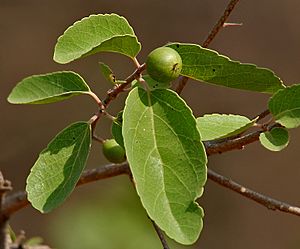Flacourtiaceae facts for kids

Flacourtiaceae was the name of a large family of flowering plants. Imagine a big group of plants that scientists once thought belonged together. This family included many different kinds of trees and shrubs, especially those found in tropical and subtropical parts of the world.
However, as scientists learned more about plants, especially by studying their DNA, they discovered that the plants in Flacourtiaceae weren't as closely related as they first thought. Because of this new information, the Flacourtiaceae family no longer exists as a recognized plant family. Its members have been moved and divided into other plant families.
Contents
What Happened to Flacourtiaceae?
When scientists find new evidence, they sometimes change how they classify living things. This is like reorganizing a library when you find a better way to group books. For the Flacourtiaceae family, advanced genetic studies showed that its members actually belonged in other, already existing plant families.
Reclassifying Plant Families
The biggest change for the plants that were once in Flacourtiaceae was their move to the Salicaceae family. This is the same family that includes well-known trees like willows and poplars. It might seem strange that tropical plants could be grouped with willows, but genetic evidence showed they share a common ancestor.
Other plants from the old Flacourtiaceae family were also moved to different families. This process helps scientists create a more accurate "family tree" of all life on Earth, showing how different species are truly related.
Plants That Were Once in This Family
Even though the Flacourtiaceae family is no longer used, many interesting plants were once part of it. These plants are now important members of other families.
- Flacourtia: This group of plants includes species like the governor's plum (Flacourtia indica). These are often small trees or shrubs that produce edible fruits. They are found in tropical regions of Asia and Africa.
- Dovyalis: Known for plants like the kei apple (Dovyalis caffra), which produces tart, yellow fruits. These are often spiny shrubs or small trees.
- Casearia: This group includes many species of trees and shrubs found in tropical areas around the world. Some are used in traditional medicine.
These are just a few examples of the diverse plants that were once grouped under Flacourtiaceae. They show how much we learn as scientific tools and knowledge improve.
Why Plant Classification Changes
Plant classification is not set in stone. It's a dynamic field where new discoveries constantly refine our understanding.
The Role of DNA in Classification
In the past, scientists classified plants mainly by looking at their physical features, like the shape of their leaves, flowers, and fruits. While this was helpful, it sometimes led to mistakes because plants can look similar without being closely related.
Today, scientists use DNA sequencing to look at the genetic code of plants. This is like reading the instruction manual for each plant. By comparing DNA, they can see the true evolutionary relationships between different species. This modern approach led to the reorganization of the Flacourtiaceae family and many other plant groups. It helps us understand the amazing diversity of life on our planet more accurately.
See also
 In Spanish: Flacourtiaceae para niños
In Spanish: Flacourtiaceae para niños

